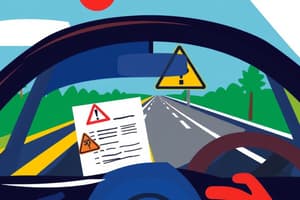Podcast
Questions and Answers
What is a key aspect of defensive driving?
What is a key aspect of defensive driving?
- Communicating clearly with other drivers (correct)
- Driving aggressively
- Ignoring blind spots
- Not using turn signals
Which of the following is NOT covered in driver education programs?
Which of the following is NOT covered in driver education programs?
- Using turn signals
- Inspecting brake pads
- Monitoring engine performance
- Learning to drift a car (correct)
Why is understanding traffic signs important for drivers?
Why is understanding traffic signs important for drivers?
- To navigate roads safely (correct)
- To increase accident risks
- To ignore the signs and drive freely
- To disobey speed limits
What does 'rules of the road' refer to?
What does 'rules of the road' refer to?
Why is proper vehicle maintenance important for safe operation?
Why is proper vehicle maintenance important for safe operation?
What are some special driving conditions that driver education courses often cover?
What are some special driving conditions that driver education courses often cover?
What is a key challenge of nighttime driving?
What is a key challenge of nighttime driving?
How do driver education courses teach students to handle wet weather conditions?
How do driver education courses teach students to handle wet weather conditions?
What is one aspect of maintaining vehicle health that drivers should pay attention to?
What is one aspect of maintaining vehicle health that drivers should pay attention to?
Why is practicing defensive driving techniques important?
Why is practicing defensive driving techniques important?
Flashcards are hidden until you start studying
Study Notes
Driver Education: Essential Skills and Concepts
Driver education encompasses various skills and concepts aimed at preparing individuals to safely operate vehicles on roads. These areas include driving under special conditions, understanding traffic signs, abiding by rules of the road, practicing defensive driving techniques, and maintaining vehicle health.
Driving Under Special Conditions
Special driving conditions refer to situations requiring heightened attention and skill, such as nighttime driving, driving in rain or snow, and navigating one-way streets. Many driver education courses cover these scenarios, teaching students how to adapt to different environments and maintain safety while behind the wheel.
Nighttime Driving
Nighttime driving presents unique challenges due to reduced visibility. Students learn how to adjust their vision to dark conditions, utilize headlights effectively, and avoid glare. They also practice scanning the road ahead carefully to spot potential hazards or changes in the environment.
Rain and Snow
Operating a vehicle during wet weather requires additional caution due to slippery surfaces. Students learn how to slow down gradually, increase braking distance, and keep a safe following distance from other cars. They also study the effects of rain and snow on tire traction and how to handle skidding or hydroplaning.
One-Way Streets
Navigating one-way streets involves paying close attention to traffic signs and signals, as well as understanding local laws regarding right-of-way. Students learn how to properly turn onto and exit one-way streets, ensuring the safety of themselves and others on the road.
Traffic Signs
Understanding traffic signs is crucial for navigating roads safely. Driver education programs cover the meanings of various signs, such as stop signs, yield signs, and speed limit signs, and teach students how to respond appropriately to each type of sign. Additionally, they discuss the purpose of warning symbols, such as those indicating upcoming curves or sharp turns.
Rules of the Road
Rules of the road govern the behavior of drivers on public roads. These guidelines include using turn signals, stopping at red lights, and obeying speed limits. Adhering to these rules helps ensure smooth traffic flow and promotes safety for everyone on the road. Students learn about common driving infractions, such as running red lights or failing to signal, and the consequences of not complying with these regulations.
Defensive Driving
Defensive driving strategies involve anticipating potential hazards and taking proactive steps to avoid accidents. Techniques taught in driver education courses include staying aware of blind spots, maintaining situational awareness, and communicating clearly with other drivers. Students also learn how to react in emergency situations, such as swerving to avoid a pedestrian or applying appropriate countermeasures in response to aggressive driving.
Vehicle Maintenance
Maintaining a vehicle in good working condition is essential for safe operation. Driver education programs cover basic vehicle maintenance tasks, such as checking tire pressure, inspecting brake pads, and monitoring engine performance. Students also learn about regular car cleaning, keeping records of maintenance activities, and planning for unexpected repairs.
Studying That Suits You
Use AI to generate personalized quizzes and flashcards to suit your learning preferences.




